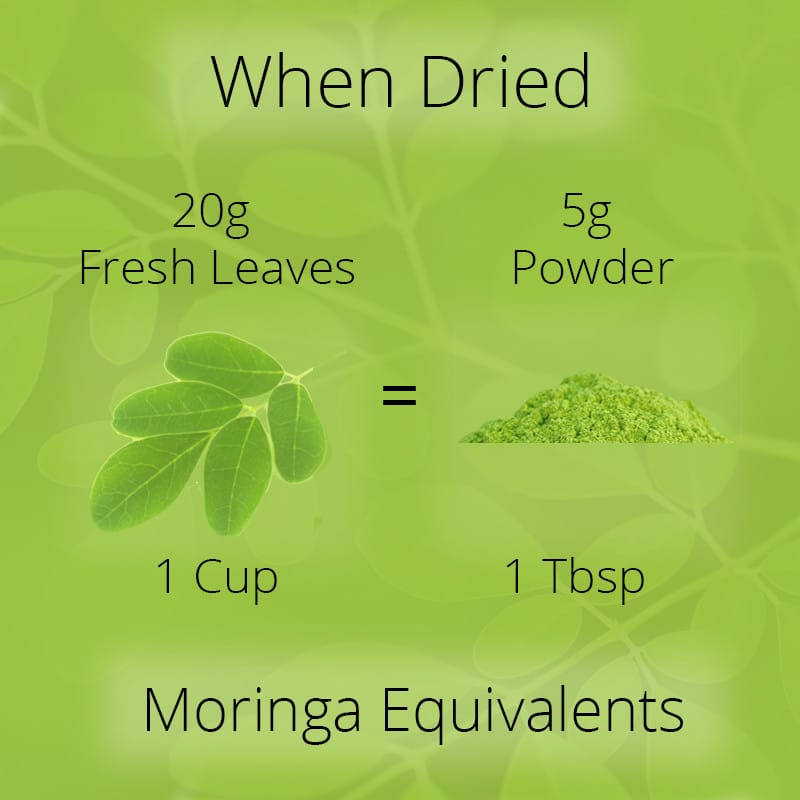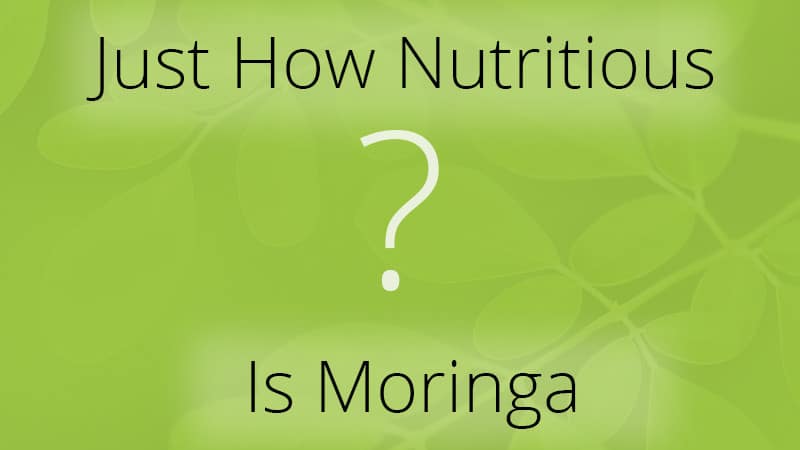So Just how Nutritious is Moringa Oleifera?
Have you noticed the incredible claims about Moringa’s nutrition don’t always agree? For example, you may read on one website “Moringa has 17x the calcium of milk,” while another website states “Moringa has 4x the calcium of milk”. How nutritious is Moringa oleifera? That’s a huge difference! And the discrepancies aren’t just limited to the calcium content of Moringa leaves either. In fact, the vitamin C content discrepancy is even greater! Some claim Moringa has 7x the vitamin C of oranges while others claim Moringa has only 0.5x the vitamin C of oranges.
So which claim is true? Just how nutritious is Moringa oleifera?
In short, the answer is — it depends.
To understand why, consider how Moringa is typically eaten. Not including using the leaves to make a tea, Moringa is typically digested in one of two forms–fresh leaves or dried leaf powder.
Fresh Moringa leaves have a moisture content of 75 – 80%, while dried leaves have a moisture content of less than 10%. That means that 1 lb of Moringa powder starts out as roughly 3.5 – 4.5 lbs of fresh leaves! (Click here if you thought it took 7 lbs of fresh Moringa leaves to make 1 lb of powder.)
So if you start with 3.5 – 4.5 lbs of fresh leaves and dry them, shouldn’t the 1 lb of dried leaves have all the nutrition of the 3.5 – 4.5 lbs of fresh leaves you started with? In other words, by drying, aren’t you effectively “concentrating” all the nutrient levels by removing only the water? Not exactly. Unfortunately, when drying Moringa leaves, like any other food, more than just the moisture content changes.
Moringa Nutrient Levels Change during the Drying Process
As stated in one textbook on the topic:
Food degeneration during dehydration by drying is chemical (enzymatic and non enzymatic browning reaction, lipid oxidation, color loss), physical and structural (rehydration, solubility, texture, and aroma loss), and nutritional (vitamin loss, protein loss, and microbial changes). All changes depend on water activity, temperature and exposure time. [1]
For our current discussion, we are most concerned with the nutritional loss mentioned above. Key factors that determine how much nutrient loss accompanies the drying process are: the drying time, the drying temperature, and the amount of exposure to light and ultraviolet radiation.
Nutrient Losses from Drying Moringa leaves
Exactly what nutrients and the level of nutrient loss that occurs during the drying process are dependent on the drying method. Some traditional methods for drying Moringa include shade drying and sun drying. More recently people also employ solar dryers or large scale industrial dryers, including freeze dryers, to dry fresh Moringa leaves. While no drying method is perfect, some are certainly better than others. In general, the highest levels of nutrients are retained when the Moringa leaves are dried as quickly as possible with minimal exposure to light, heat, and air.
Vitamin Loss
Vitamin C, the B vitamins thiamin (B1) and folate (B9), as well as vitamin A become unstable when the harvested moringa leaves are exposed to heat, air, or light. During the drying process, exposure can be minimized but some level of exposure is unavoidable. Vitamins are actually the most unstable nutrients when drying and are reduced by the greatest amount. In general, according to USDA Table of Nutrient Retention Factors, vitamin C can be reduced by up to 80%; folate (B9) and vitamin A can be reduced by up to 50%; and thiamin (B1) can be reduced by up to 30% during the drying process alone [2]. When the dried leaves are later pulverized into a powder, further losses can occur as more leaf surface area is exposed to both light and air.
Mineral Loss
Minerals are much more stable through the drying process and food processing, in general, when compared to vitamins. Yet even minerals when exposed to heat, air, or light undergo changes. Copper, iron, and zinc are also affected by moisture and may react with other food components such as carbohydrates or proteins. [3]
Thankfully, when drying Moringa leaves, most processes don’t significantly change the mineral content.
Macro Nutrient Loss
Although reactions do occur between macronutrients such as carbohydrates and proteins, there is not a significant loss during the drying process. [4]
Average Nutritional Data of Fresh Moringa Leaves and Dried Moringa Leaves
With the understanding of both the amount of fresh leaves that it takes to make powder as well as the changes that happen during the drying process, let’s take a look at some actual nutritional data. The chart below has the most comprehensive review of nutritional data for fresh and dried leaves that I have seen [5]. It pulls data from a number of sources. The authors state:
A search of the literature on the nutrient content of Moringa oleifera leaves was performed using PubMed as well as internet searches, with an emphasis on locating original sources of information reported in the last 20 years. Papers in professional publications where the methods were described and analyses from university and commercial labs specializing in nutrient analysis were included. One unpublished analysis of a sample of Moringa leaf powder by a professional laboratory in 2011 was also included.
This summary provides data on the nutrient content of mature leaves. For dried leaves, values for sun, shade, and oven dried were utilized; but values for leaves which had been blanched, sulfited, or freeze dried were omitted as these procedures are less commonly available. Several authors provided data for different cultivars or harvests. Some of these authors provided data for each sample, and others averaged the samples together.When the data for individual samples were provided, the individual samples were averaged and used as one value. [5]
The chart shows typical nutrients (column 1) and the levels found in fresh, raw Moringa leaves (column 2), and Moringa leaf powder (column 3). The fourth column shows nutrient levels in 100 g of Moringa powder divided by nutrient levels in 100 g of fresh Moringa leaves. If all nutrients were maintained during the drying process we would expect column 4 to show 3.5-4.5x greater levels.
There are a few anomalies in the chart I want to point out. Firstly, fat, sodium (Na), and magnesium (Mg) all show that the dried leaves have more than the 3.5-4.5x increase established above. It should be understood that these nutrients can’t be increased to levels higher than found in the original fresh leaves. These numbers are anomalies due to different fresh and dried leaf samples being compared which both have high levels of variation. Secondly, the “na” listed by certain nutrients means that data was not available. It doesn’t mean that the levels are zero for the nutrients listed.
Moringa Nutritional Data Chart
[table id=2 /][5]
Dried Moringa leaves typically have 3.5-4.5x higher nutrient levels than fresh Moringa leaves when equal weights are compared.
We can see this clearly from the chart, but let’s remember this is only because it takes 3.5-4.5 lbs of leaves to make the 1 lb of dry powder. So while the drying processes does have the effect of concentrating nutrients; there is, at the same time, significant nutrient losses from vitamins A, B1, B9, and C.
It is always more nutritious to eat the fresh leaves vs. drying and eating them!
I want to be very clear on this point. A typical serving of Moringa powder is around 1 tbsp or 5g. A typical serving of fresh Moringa leaves is 1 cup or 20g. Both servings, 5g of dry powder or 20g of fresh leaves, start out as approximately 20g of fresh leaves. Therefore, given the option of 1 serving of fresh Moringa leaves or 1 serving of Moringa leaf powder, there will always be greater nutrition from the fresh Moringa leaves. Eating the 1 serving fresh means that no nutrients have been lost through the drying process.

So Just How Nutritious is Moringa Oleifera?
Let’s circle back around to a couple of the claims we started with, “Moringa has 17x the calcium of milk,” vs “Moringa has 4x the calcium of milk”.
Now you know, even though the authors may have left out the basis of their comparison, the first claim is comparing Moringa powder to milk while the second claim is comparing fresh Moringa leaves to milk. You also know that on a per serving basis, you would get the same amount of calcium whether you have 5g of dry powder or 20g of fresh leaves.
How about these claims: “Moringa has 7x the vitamin C of oranges” vs “Moringa has only 0.5x the vitamin C of oranges.” You should recognize that the first claim is comparing fresh Moringa leaves, and the second is comparing Moringa powder. Remember most of the vitamin C is lost through the drying and pulverizing process. In this example, on a per serving basis, you would get 56 times more vitamin C eating 20g of fresh leaves vs. eating 5 g of Moringa powder!
As the data in the above chart shows, both fresh Moringa and Moringa powder are incredibly nutritious to eat. In the next article we will delve into the significance of the nutritional data presented, highlight some other incredible nutritional aspects of Moringa, and then compare Moringa to other Superfoods you may be familiar with.
Please comment below with questions or suggestions of topic areas you would like to see covered regarding Moringa.
- Help, I’m having trouble using my Moringa Oil! - February 22, 2023
- Want to grow (and eat) Moringa? - April 14, 2022
- Can Moringa help protect you from the Coronavirus COVID-19? - March 15, 2020


Why dried moringa leaves contain more nutrients compared to fresh leaves??
Excellent comparisons between dry and fresh moringa
Nice article its very helpfull thanks for sharing